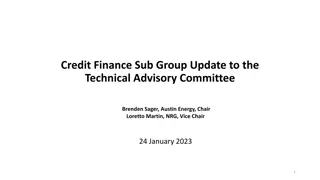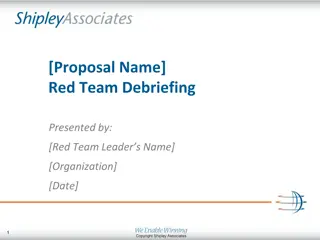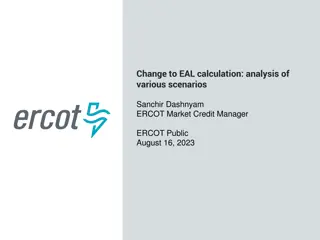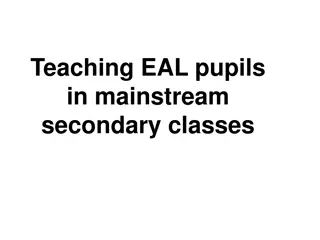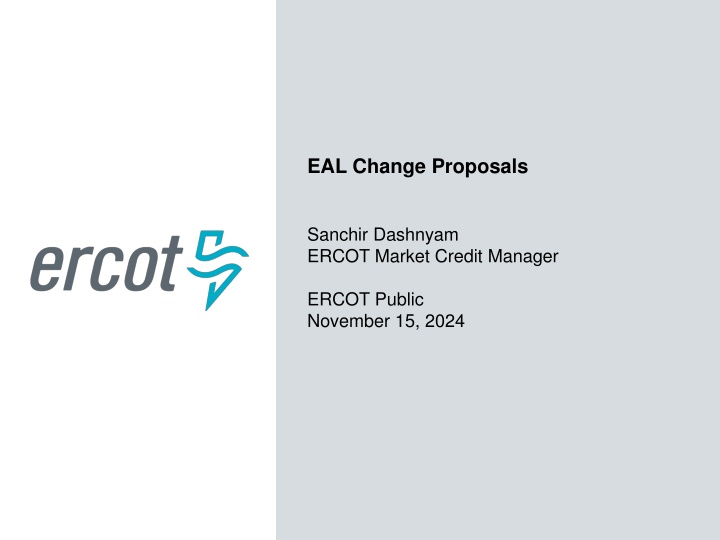
Optimizing Market Credit Strategies in ERCOT for Improved Performance
Explore the proposed changes in ERCOT market credit management by Sanchir Dashnyam, focusing on enhancing the EAL formula for better risk assessment and mitigation. The revisions aim to apply forward factors to historical exposures effectively, ensuring a more robust approach to credit evaluation in ERCOT markets.
Uploaded on | 0 Views
Download Presentation

Please find below an Image/Link to download the presentation.
The content on the website is provided AS IS for your information and personal use only. It may not be sold, licensed, or shared on other websites without obtaining consent from the author. If you encounter any issues during the download, it is possible that the publisher has removed the file from their server.
You are allowed to download the files provided on this website for personal or commercial use, subject to the condition that they are used lawfully. All files are the property of their respective owners.
The content on the website is provided AS IS for your information and personal use only. It may not be sold, licensed, or shared on other websites without obtaining consent from the author.
E N D
Presentation Transcript
EAL Change Proposals Sanchir Dashnyam ERCOT Market Credit Manager ERCOT Public November 15, 2024
Current EAL Formula vs. Proposal(s) Current: Apply the forward factor to the highest extrapolated historical RTM average exposures over the look back period. EAL = Max [IEL during the first 40-day period only beginning on the date that the Counter-Party commences activity in ERCOT markets, RFAF * Max {RTLE during the previous lrq days}, RTLF] + DFAF * DALE + Max [RTLCNS, Max {URTA during the previous lrq days}] + OUT+ ILE Scenario #6: Apply the forward factor to each historical netted average extrapolated exposures and take the highest over the look back period. EAL = Max [Max {NLE*RFAF during the previous lrq days}, FAF*NLF] + Max [(RTLCNS + UDAA),Max {ULE during the previous lrq days}] + OUT + ILE 1. NLE = Net liability extrapolated (Last 14 days RTM Initial Statement Average + Last 14 days DAM Initial Statement Average based on RTM Initial OD)*M1. Match RTM and DAM operating days. NLCD = (7 most recent Operating days Real time estimates + 7 DAM ODs day-ahead estimates) no price cap. Match RTM and DAM operating days. Use actuals if available, if not, use estimates. NLF = net liability forward = 1.5 * NLCD FAF = 21 day futures prices / most recent days 7 RTM Prices corresponding to the 7 days in NLF. Set a floor of 1 for FAF. ULE = unbilled liability extrapolated (Last 14 days RTM Initial Statement Average + Last 14 days DAM Initial Statement Average based on RTM Initial OD)*M2. Match RTM and DAM operating days. RFAFi = 21-day future prices / 14 days RTM Prices corresponding to the 14 days in NLEi. Cap RFAF at 1.5. RFAF is applied against NLE. There is a floor for RFAF at 0.50. For each RFAF, we are using the corresponding Operating Day (and not Invoice Business Day) RTM settled prices, which match the respective operating Days in the NLE. For MCE use similar RFAF applied to NLE (No floor Or Cap) for a minimum of 2 days for load. Look-back periods: a) summer months: 40 days from May 16 through Sep 15 b) non summer months: 20 days lookback from Sep 16 through May 15. c) Traders 20 days irrespective of months. Strip out impact of CARD invoices from both invoice exposures and TPEA. This is for analysis purposes only (CARD will stay in TPEA in implementation). 2. 3. 4. 5. 6. 7. 8. 9. 2 ERCOT Public
Current EAL Formula vs. Proposal(s) Current: Apply the forward factor to the highest extrapolated historical RTM average exposures over the look back period. EAL q = Max [IEL during the first 40-day period only beginning on the date that the Counter-Party commences activity in ERCOT markets, RFAF * Max {RTLE during the previous lrq days}, RTLF] + DFAF * DALE + Max [RTLCNS, Max {URTA during the previous lrq days}] + OUT+ ILE Scenario #2c: Apply the forward factor to each extrapolated historical average exposures and take the highest over the look back period. EAL q = Max [IEL during the first 40-day period only beginning on the date that the Counter-Party commences activity in ERCOT markets, Max{(RFAF * Max {RTLE) during the previous lrq days}, RTLF] + DFAF * DALE + Max [RTLCNS, Max {URTA during the previous lrq days}] + OUT + ILE 1. 2. Minimum of 2 days for MCE for load (vs. 1 day for the current framework) Look-back periods: a) 40 days from May 16 through Sep 15 (summer months) and 20 days lookback from Sep 16 through May 15 (non summer months) b) Traders 20 days irrespective of months. 3 ERCOT Public
TPEA-Current vs TPEA for Final proposal: 1/1/2022 through 8/30/2024 Overall market Overcollateralization issue caused by Double top/higher 2ndtop is resolved Lower peaks and higher valleys Less sharp up/down volatility 4 ERCOT Public
Double top or 2nd higher top example - TPEA Disadvantage of the current EAL formula: Overcollateralization and the related cost to the marketplace caused by Double top or higher 2nd top , which was brought up by a number of market participants. The current EAL/TPEA framework could lead to unreasonably high collateralization (large positive gaps), especially when the high volatility event is followed up by another price surge. This is due to the current framework applying the forward factor against the highest extrapolated historical exposure. 5 ERCOT Public
Double top or 2nd higher top example - gaps Both proposals will address the double top issue. However, S6 results in an increase in negative gaps vs. S2c in high stress events. 6 ERCOT Public
Negative and Positive Gaps: overall 1/1/22 through 8/30/24 Overall Negative Gap Current S2c S6 Positive Gap Current S2c S6 Sum total Change, %# of occurences Change, % (19,509,668,257) $ (17,839,681,688) $ -9% (17,441,536,061) $ -11% Sum total Change, %# of occurences Change, % 1,005,339,567,917 $ 940,433,483,877 $ -6% 926,618,033,305 $ -8% Average Change, % (1,296,323) $ (1,258,443) $ (1,218,240) $ Average Change, % 3,180,005 $ 2,967,154 $ 2,932,837 $ 15,050 14,176 14,317 -6% -5% -3% -6% 316,144 316,948 315,946 0% 0% -7% -8% Load & Gen Negative Gap Current S2c S6 Positive Gap Current S2c S6 Sum total Change, %# of occurences Change, % (12,723,191,735) $ (11,590,346,453) $ -9% (11,983,456,158) $ -6% Sum total Change, %# of occurences Change, % 713,785,160,521 $ 658,330,040,050 $ -8% 648,207,126,905 $ -9% Average Change, % (4,601,516) $ (4,734,619) $ (5,281,382) $ Average Change, % 19,593,334 $ 17,866,100 $ 17,585,175 $ 2,765 2,448 2,269 -11% -18% 3% 15% 36,430 36,848 36,861 -9% -10% 1% Load Negative Gap Current S2c S6 Positive Gap Current S2c S6 Sum total Change, %# of occurences Change, % (3,777,881,322) $ (3,383,799,883) $ -10% (2,796,781,785) $ -26% Sum total Change, %# of occurences Change, % 70,672,417,715 $ 61,963,106,772 $ -12% 73,881,972,593 $ 5% Average Change, % (1,069,313) $ (1,072,860) $ (1,025,589) $ Average Change, % 2,149,404 $ 1,872,903 $ 2,229,861 $ 3,533 3,154 2,727 -11% -23% 0% -4% 32,880 33,084 33,133 1% 1% -13% 4% Traders Negative Gap Current S2c S6 Positive Gap Current S2c S6 Sum total Change, %# of occurences Change, % (2,466,849,084) $ (2,362,021,452) $ -4% (2,097,610,024) $ -15% Sum total Change, %# of occurences Change, % 134,367,292,674 $ 134,590,680,456 $ 0% 121,083,787,499 $ -10% Average Change, % (407,071) $ (397,245) $ (318,544) $ Average Change, % 828,957 $ 829,399 $ 750,470 $ 6,060 5,946 6,585 -2% 9% -2% -22% 162,092 162,275 161,344 0% 0% 0% -9% 7 ERCOT Public
Negative and Positive Gaps: Elliott (December 2022) Overall Negative Gap Sum total Change, %# of occurences Change, % Current (1,849,594,396) $ S2c (1,718,248,010) $ S6 (1,876,304,346) $ Positive Gap Sum total Change, %# of occurences Change, % Current 57,618,172,457 $ S2c 49,159,840,886 $ S6 49,949,433,459 $ Average Change, % (2,003,894) $ (1,941,523) $ (2,156,672) $ Average Change, % 2,945,263 $ 2,506,876 $ 2,554,174 $ 923 885 870 -7% 1% -4% -6% -3% 8% 19,563 19,610 19,556 -15% -13% 0% 0% -15% -13% Load & Gen Negative Gap Current S2c S6 Positive Gap Current S2c S6 Sum total Change, %# of occurences Change, % (1,373,826,432) $ (1,258,796,162) $ -8% (1,431,219,291) $ 4% Sum total Change, %# of occurences Change, % 38,604,849,118 $ 31,821,986,891 $ -18% 33,748,383,042 $ -13% Average Change, % (7,118,272) $ (6,993,312) $ (8,726,947) $ Average Change, % 17,142,473 $ 14,006,156 $ 14,939,523 $ 193 180 164 -7% -15% -2% 23% 2,252 2,272 2,259 -18% -13% 0% Load Negative Gap Current S2c S6 Positive Gap Current S2c S6 Average Change, % (1,037,508) $ (1,013,456) $ (1,094,425) $ Average Change, % 3,241,650 $ 2,364,506 $ 2,501,954 $ Sum total Change, %# of occurences Change, % (342,377,744) $ (331,400,059) $ -3% (279,078,392) $ -18% Sum total Change, %# of occurences Change, % 5,864,145,503 $ 4,272,661,559 $ -27% 4,728,693,459 $ -19% 330 327 255 -1% -23% -2% 5% 1,809 1,807 1,890 0% 4% -27% -23% Traders Negative Gap Current S2c S6 Positive Gap Current S2c S6 Sum total Change, %# of occurences Change, % (91,537,735) $ (89,060,499) $ -3% (128,218,318) $ 40% Sum total Change, %# of occurences Change, % 8,835,542,052 $ 8,758,328,158 $ -1% 7,315,262,740 $ -17% Average Change, % (366,151) $ (368,019) $ (414,946) $ Average Change, % 898,560 $ 889,803 $ 751,671 $ 250 242 309 -3% 24% 1% 13% 9,833 9,843 9,732 0% -1% -1% -16% 8 ERCOT Public
Negative and Positive Gaps: Heather (January 2024) Overall Negative Gap Current S2c S6 Positive Gap Current S2c S6 Sum total Change, %# of occurences Change, % (444,055,441) $ (399,231,084) $ -10% (440,760,452) $ -1% Sum total Change, %# of occurences Change, % 49,898,272,197 $ 58,326,151,610 $ 17% 47,095,886,236 $ -6% Average Change, % (393,666) $ (383,876) $ (380,951) $ Average Change, % 2,400,340 $ 2,788,990 $ 2,268,260 $ 1,128 1,040 1,157 -8% 3% -2% -3% 20,788 20,913 20,763 1% 0% 16% -6% Load & Gen Negative Gap Current S2c S6 Positive Gap Current S2c S6 Sum total Change, %# of occurences Change, % (97,486,615) $ (95,970,695) $ -2% (128,252,635) $ 32% Sum total Change, %# of occurences Change, % 33,706,032,895 $ 39,021,253,765 $ 16% 32,413,361,618 $ -4% Average Change, % (928,444) $ (1,156,273) $ (1,322,192) $ Average Change, % 14,186,041 $ 16,124,485 $ 13,573,435 $ 105 83 97 -21% -8% 25% 42% 2,376 2,420 2,388 14% -4% 1% Load Negative Gap Current S2c S6 Positive Gap Current S2c S6 Sum total Change, %# of occurences Change, % (177,308,911) $ (136,899,729) $ -23% (140,927,826) $ -21% Sum total Change, %# of occurences Change, % 3,840,602,406 $ 5,073,757,405 $ 32% 4,501,729,425 $ 17% Average Change, % (545,566) $ (538,975) $ (527,820) $ Average Change, % 1,672,736 $ 2,133,624 $ 1,941,237 $ 325 254 267 -22% -18% -1% -3% 2,296 2,378 2,319 4% 1% 28% 16% Traders Negative Gap Current S2c S6 Positive Gap Current S2c S6 Sum total Change, %# of occurences Change, % (123,215,265) $ (123,442,007) $ 0% (124,118,281) $ 1% Sum total Change, %# of occurences Change, % 9,604,166,605 $ 11,180,333,351 $ 16% 7,611,904,363 $ -21% Average Change, % (267,859) $ (263,765) $ (230,703) $ Average Change, % 861,515 $ 1,003,260 $ 686,871 $ 460 468 538 2% 17% -2% -14% 11,148 11,144 11,082 0% -1% 16% -20% 9 ERCOT Public
Negative and Positive Gaps: Summer of 2022 Overall Negative Gap Current S2c S6 Positive Gap Current S2c S6 Sum total Change, %# of occurences Change, % (3,983,510,674) $ (3,826,708,405) $ -4% (2,984,543,282) $ -25% Sum total Change, %# of occurences Change, % 251,794,205,422 $ 237,032,821,249 $ -6% 249,693,401,346 $ -1% Average Change, % (2,339,114) $ (2,423,501) $ (1,919,320) $ Average Change, % 5,443,493 $ 5,113,425 $ 5,402,164 $ 1,703 1,579 1,555 -7% -9% 4% -18% 46,256 46,355 46,221 0% 0% -6% -1% Load & Gen Negative Gap Current S2c S6 Positive Gap Current S2c S6 Sum total Change, %# of occurences Change, % (3,417,047,629) $ (3,283,825,883) $ -4% (2,519,360,826) $ -26% Sum total Change, %# of occurences Change, % 180,776,736,418 $ 167,458,327,034 $ -7% 180,902,895,349 $ 0% Average Change, % (8,852,455) $ (10,802,059) $ (10,585,550) $ Average Change, % 31,838,101 $ 29,102,942 $ 31,238,628 $ 386 304 238 -21% -38% 22% 20% 5,678 5,754 5,791 -9% -2% 2% Load Negative Gap Current S2c S6 Positive Gap Current S2c S6 Sum total Change, %# of occurences Change, % (155,330,878) $ (141,571,912) $ -9% (100,219,359) $ -35% Sum total Change, %# of occurences Change, % 15,569,757,183 $ 14,465,352,805 $ -7% 16,097,667,199 $ 3% Average Change, % (469,278) $ (475,074) $ (396,124) $ Average Change, % 3,423,429 $ 3,193,235 $ 3,535,618 $ 331 298 253 -10% -24% 1% -16% 4,548 4,530 4,553 0% 0% -7% 3% Traders Negative Gap Current S2c S6 Positive Gap Current S2c S6 Sum total Change, %# of occurences Change, % (340,032,762) $ (329,233,810) $ -3% (289,963,584) $ -15% Sum total Change, %# of occurences Change, % 31,691,585,787 $ 30,610,529,925 $ -3% 28,727,572,858 $ -9% Average Change, % (539,735) $ (530,167) $ (414,234) $ Average Change, % 1,428,321 $ 1,379,101 $ 1,302,838 $ 630 621 700 -1% 11% -2% -23% 22,188 22,196 22,050 0% -1% -3% -9% 10 ERCOT Public
Negative and Positive Gaps: Summer of 2023 Overall Negative Gap Current S2c S6 Positive Gap Current S2c S6 Sum total Change, %# of occurences Change, % (8,124,628,084) $ (6,751,128,947) $ -17% (7,056,784,158) $ -13% Sum total Change, %# of occurences Change, % 257,521,311,638 $ 257,321,805,720 $ 0% 256,742,050,975 $ 0% Average Change, % (2,668,187) $ (2,513,451) $ (2,866,281) $ Average Change, % 5,120,115 $ 5,074,780 $ 5,040,384 $ 3,045 2,686 2,462 -12% -19% -6% 7% 50,296 50,706 50,937 1% 1% -1% -2% Load & Gen Negative Gap Current S2c S6 Positive Gap Current S2c S6 Sum total Change, %# of occurences Change, % (4,636,750,017) $ (3,658,235,228) $ -21% (4,704,339,341) $ 1% Sum total Change, %# of occurences Change, % 190,734,277,550 $ 192,799,052,159 $ 1% 183,643,292,050 $ -4% Average Change, % (6,941,243) $ (6,463,313) $ (8,616,006) $ Average Change, % 33,848,142 $ 33,454,633 $ 31,904,672 $ 668 566 546 -15% -18% -7% 24% 5,635 5,763 5,756 -1% -6% 2% Load Negative Gap Current S2c S6 Positive Gap Current S2c S6 Sum total Change, %# of occurences Change, % (2,374,682,786) $ (2,044,656,019) $ -14% (1,665,209,553) $ -30% Sum total Change, %# of occurences Change, % 15,432,903,845 $ 13,752,839,155 $ -11% 24,437,217,610 $ 58% Average Change, % (2,355,836) $ (2,493,483) $ (2,489,102) $ Average Change, % 2,991,453 $ 2,566,786 $ 4,436,677 $ 1,008 820 669 -19% -34% 6% 6% 5,159 5,358 5,508 4% 7% -14% 48% Traders Negative Gap Current S2c S6 Positive Gap Current S2c S6 Sum total Change, %# of occurences Change, % (1,003,297,359) $ (950,468,114) $ -5% (571,791,143) $ -43% Sum total Change, %# of occurences Change, % 27,005,665,896 $ 26,989,200,850 $ 0% 25,166,126,216 $ -7% Average Change, % (1,021,688) $ (1,001,547) $ (643,185) $ Average Change, % 1,036,527 $ 1,033,911 $ 962,376 $ 982 949 889 -3% -9% -2% -37% 26,054 26,104 26,150 0% 0% 0% -7% 11 ERCOT Public
Cost of the proposed framework: 1/1/2022 through 8/30/24 Based on historical market behaviors, the proposed EAL framework (S2c) would have saved the market about 6% or approximately $17MM over the period analyzed with the specific breakout by market activity type as follows: Gen Load Load and Gen Trader Total S2c Change, % S6 (1,364,839) 1,148,042 (17,763,984) (3,538,096) $ (21,001,074) $ Change, % $ $ $ $ $ (663,378) (2,278,017) (14,882,955) 89,878 (17,325,061) -10% -7% -7% 0% -6% $ $ $ -21% 3% -8% -14% -7% Cost estimate assumptions: Cost of capital is 10% for all counterparties for each day during the period analyzed 10% cost is across all collateral instruments: cash, LC & Surety bonds Excludes consideration for collateral for DAM, CRR or excess/discretionary collateral Table above excluded data for inactive and CRRAH counterparties 12 ERCOT Public
ERCOT recommendation: S2c Scenario #2c: Advantages: 1. 2. 3. Solves the overcollateralization issue due to double top Reduces negative gaps across the board for all MP activity type and all periods analyzed Easier to implement vs. S6: Scenario 2c cost estimate $ Scenario 6 cost range - $$$$ Disadvantages: 1. For some entities and under certain circumstances EAL will lose the sensitivity to futures movements Scenario #6: Advantages: 1. 2. Solves the overcollateralization issue due to double top Reduces negative gaps for most entities, especially for load Disadvantages: 1. 2. 3. For some periods, increases negative gaps for some MP s or segment of the market (e.g., Traders) Costly to implement vs. S2c. Cost and length of implementation could be as much 4 times compared to S2c For some entities and under certain circumstances EAL will lose the sensitivity to futures movements 13 ERCOT Public

